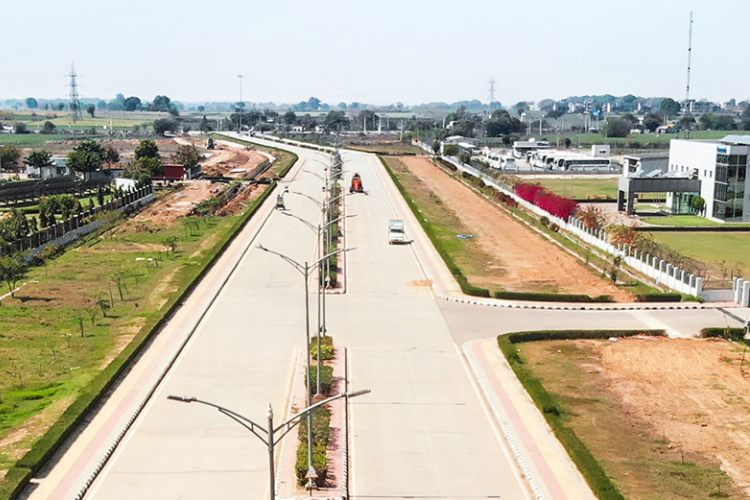
India is constructing a 90 billion dollar industrial corridor between Delhi and Mumbai. This industrial park will boost India's economy and transform local economies. The Delhi Mumbai industrial Corridor was first introduced in 2006.
This industrial estate was planned for the 2008 Beijing Olympics to feed the infrastructure requirements for the games. India's iron ore exports were shifted from Japan to China, efforts were made to obtain ore for Japan from other areas of India.
However, due to the non-existent infrastructure it was logistically difficult and not cost effective to solve this problem for future cases. Then the Japanese ambassador came to India to raise the idea of an efficient freight corridor, similar to the Tokyo Osaka corridor in Japan.
The idea gained support in December 2006. The Japanese and Indian government signed a memorandum of understanding initiating the project.
The Delhi Mumbai industrial corridor or DMIC will be 1483 kilometers long. This Industrial corridor will be connecting Delhi India's national capital to Mumbai its financial hub and largest port city.
The corridor will have 24 investments in industrial sectors with the investment regions being a minimum of 200 square kilometers and the industrial sectors being a minimum of 100 square kilometers.
There will be eight new industrial smart cities, two brand new international airports, an eight lane highway and two mass transit bus systems. India's first high-speed rail line, several power projects and three logistics hubs, these investments will be spread along the western dedicated freight corridor(WDFC) a massive freight train route that will serve as the corridor's backbone.
There will also be numerous smaller rail linkages feeding into the larger freight line. India hopes that the DMIC will serve as a high-tech industrial zone, providing 3 million new jobs and increasing the share of manufacturing in the Indian GDP to 25% by 2025.
For reference in 2018, manufacturing contributed only 14.8. The DMIC will be 90% funded through public-private partnerships with companies investing in industrial plots, industrial land and projects that will appreciate in value and the other 10% will come from foreign investment.
Japan has already loaned 4.5 billion dollars the DMIC, and it will spread across six states as well as Delhi, which is a small federal territory.
The first state is Uttar Pradesh, which will include one investment region and one industrial area both within 80 kilometers from new Delhi along with a 3500 megawatt power plant and a smart city in Noida which will have a logistics sub and a new international airport.
The second is Haryana, it will include two investment regions and two industrial areas in addition and there will be a smart city along with a rapid transit bus system in Gurgaon.
The third is Rajasthan, it will include two investment regions and three industrial areas a smart city with a logistics hub and the Bivari dry port and logistics hub.
The fourth is Madhya Pradesh, it will include two investment regions and two industrial areas along with a smart city called Vikram Industrial Township outside Ujjain.
The fifth is Gujarat, it will include two investment regions and three industrial areas a rapid transit bus system in Ahmedabad and the largest new city in India called Dollara. Dollara will be a massive brand new smart city that will cover 920 square kilometers and include one of the corridor's new international airports.
Lastly the sixth state is Maharashtra, it will include two investment regions and two industrial areas including the Digi port Industrial area along with three new smart cities, including the Aurangabad industrial city, a green smart city that will cover 40 square kilometers.
The eight lanes 15 billion dollar Delhi Mumbai Expressway will connect the two megacities, reducing the current 24-hour travel time to12 hours, in addition a recently approved 17 billion dollar high-speed rail line will connect to Mumbai and Ahmedabad.
It will be India's first high-speed rail line since the MOU in 2006, the corridor has progressed significantly in 2007 during Abe Shinzo's visit to India. He and Manmohan Singh were presented with the final project concept in 2008.
The DMIC development corporation a government-owned company in charge of establishing and promoting the corridor was founded in 2011. The project was officially approved, since then construction has started on many projects as of July 2020.
The western dedicated freight corridor was 56% finished; it is on track for completion in December 2021. The 1250 kilometer Mumbai-Delhi Expressway is under construction and is expected to be completed by 2023.
Since 2016 the Aurangabad Industrial city has been under construction. Satellite footage from 2019 reveals the 4.5 square kilometer first phase with many roads constructed.
On 7th September 2019, Prime Minister Narendra Modi inaugurated the city. The government of Madhya Pradesh has set aside five square kilometers for Vikram Smart City between Ujjain and Divas footage from June 2020 reveals finished roads, a water treatment plant, a sewage treatment plant, an electric substation and a water tower.
Once these utilities are complete, residential buildings will be constructed in Greater Noida and integrated Industrial Township near Delhi is being developed. It will have many high-tech industries and residential areas.
The first phases of all these new cities have received over 2 billion dollars in investment and are planned to be completed in 2025. The Ahmedabad rapid transit bus system was completed in 2009 and is fully operational.
Lastly the Mumbai-Ahemdabad high-speed rail line is supposed to begin construction soon. As of July 2020 60% of the required land have been acquired. Due to the coronavirus pandemic a lot of construction has halted but deals are still being made once restrictions are lowered.
Projects will continue the larger corridor is planned to be completed by 2037 costing a total of 90 billion US dollars whether it will succeed in boosting the Indian economy and providing millions of jobs, we will just have to wait.


